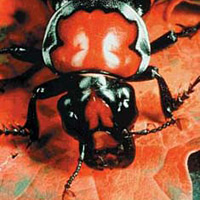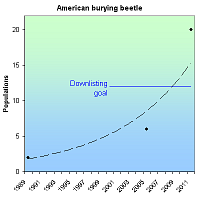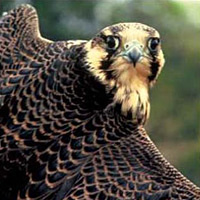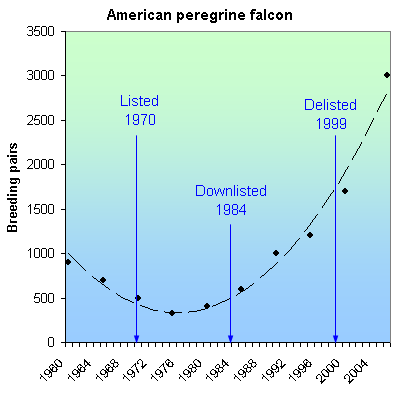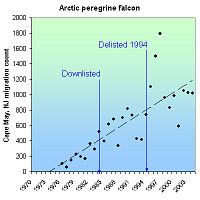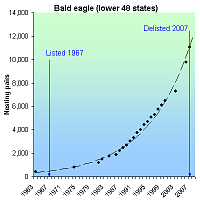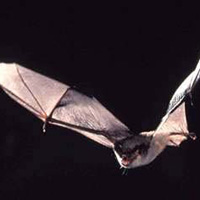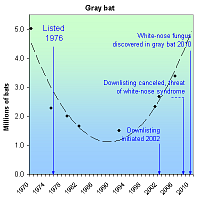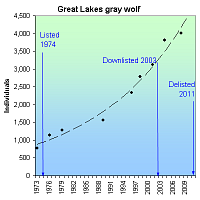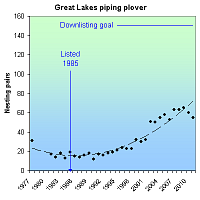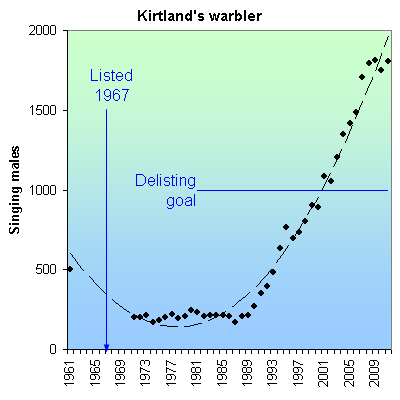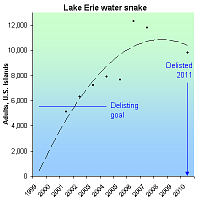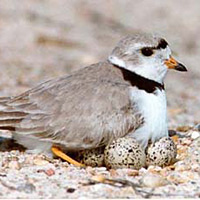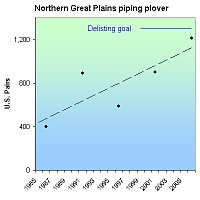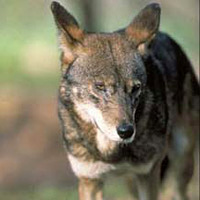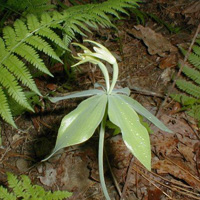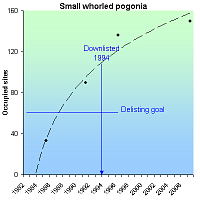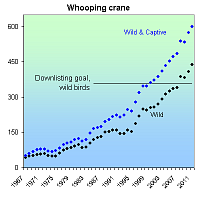American burying beetle (Nicrophorus americanus)
| Status: Endangered | Critical habitat: none |
| Listed: 8/13/1989 | Recovery plan: 9/27/1991 |
Range: AR(b), KS(b), MA(b), NE(b), OH(b), OK(b), RI(b), SD(b), TX(b) --- AL(x), CT(x), DE(x), DC(x), FL(x), GA(x), IL(x), IN(x), IA(x), KY(x), LA(x), ME(x), MD(x), MI(x), MN(x), MS(x), MO(x), MT(x), NH(x), NY(x), NJ(x), NC(x), ND(x), PA(x), SC(x), TN(x), VT(x), VA(x), WV(x), WI(x)
SUMMARY
The cause of the American burying beetle's 90% range loss is not well understood, but is thought to be due to disruptions in the food and reproductive web. It is threatened by competition, drought, invasive ants and habatat loss. When listed as endangered in 1989, there were only two known populations. Captive breeding, reintroduction efforts and intensive surveys have increased the total number of populations to 20 or more in 2011.
RECOVERY TREND
The American burying beetle (Nicrophorus americanus) is a large, spectacularly colored orange and black insect. It formerly occurred across a vast range from Nova Scotia south to Florida, west to Texas, and north to South Dakota. It was documented in 150 counties in 34 states, the District of Columbia, and three Canadian provinces. Total historical numbers are not known, but the species may well have occurred in the tens of millions. The burying beetle's dramatic decline has been called "difficult to imagine" and “one of the most disastrous declines of an insect’s range ever to be recorded” [2]. It was extirpated from mainland New England through New Jersey by the 1920s, from the entire mainland east of the Appalachian Mountains by the 1940s, and from the mainland east of the Mississippi River by 1974. It is absent from about 90 percent of its historic range.
The largest of North America's 32 burying beetles, N. americanus is uniquely dependent upon quail-size carrion weighing 100 to 200 grams [1, 15]. Males smell freshly dead mammals and birds (and occasionally even fish) within an hour of death and up to two miles away. Females arrive shortly thereafter, attracted by male pheromones. A competition ensues and is typically won by the largest male and female. Lying on their backs, the winning couple inches the carrion into an excavated burial chamber. During this time, orange phoretic mites borne by the beetles leap to the carcass, cleaning it of fly eggs and microbes. The buried carcass is relieved of its feathers, feet, tail, ears and/or fur. Now known as a "brood ball," it is coated with oral and anal embalming secretions to retard fungal and bacterial growth. The beetles then mate and within 24 hours lay eggs in the soil near the carcass. White grubs emerge three or four days later and are carried to the carcass. The parents also defend the grubs from predators and feed them regurgitated food. The American burying beetle is one of the few non-colonial insects in the world to practice dual parenting. In approximately a week, the grubs leave the chamber and pupate into adults.
The cause of the American burying beetle's decline is not well understood, but the most cogent hypotheses see it as victim of interacting food chain disturbances which reduced the number of large carcasses [2]. The passenger pigeon, which formerly occurred in the billions, was an ideal size. It was last seen in 1914 and was greatly reduced in number in the decades preceding. Its decline and disappearance occurred just prior to the burying beetle's. Other endangered or greatly reduced carrion of ideal size include the black-footed ferret, northern bobwhite, and greater prairie chicken. Competition for dwindling carrion numbers was exacerbated by increasing numbers of mid-sized predators following the extinction or decline of large predators such as the eastern cougar, mountain lion and gray wolf. In their absence, coyotes, raccoons, fox and other mid-size scavengers increased in number and consumed more quail-size carrion. Finally, as habitats became more fragmented mid-size predators were increasingly able to exploit forest and grassland edges, taking more carrion.
At the time of listing in 1989, two populations were known: one on Block Island, Rhode Island and one in eastern Oklahoma [1]. Since then, populations have been discovered in South Dakota (1995), Nebraska (1992), Kansas (1997), Arkansas (1992) and Texas (2003), as well as additional populations in Oklahoma [3, 23]. The total number of populations has increased to at least 20 as of 2011 [7, 11, 13, 10, 22, 23].
RHODE ISLAND. Located 12 miles off the south coast of Rhode Island, Block Island supports the last natural population of the American burying beetle east of the Mississippi River. The island is free of foxes, raccoons, skunks and coyotes. A study of one-third of the population determined that it was relatively stable between 1991 and 1997 (mean=184), steadily grew to 777 in 2006, and then declined to 80 in 2011 in part because of a reduction in supplementation of carcasses [8]. This population served as the source for the successful Roger Williams Park Zoo captive breeding program initiated in 1994 and for direct translocations to Nantucket and Penikese Island.
MASSACHUSETTS. The American burying beetle was extirpated from Massachusetts shortly after 1940 [1] and was reintroduced to the 70-acre Penikese Island in Buzzards Bay over a four-year period between 1990 and 1993. Reintroduced beetles initially came from a Boston University captive breeding population originating from Block Island stock [6]. The population persisted at low numbers through 2002, but was not located in 2003, 2004 or 2005. On Nantucket, 2,892 beetles were introduced from the Roger Williams Park Zoo between 1994 and 2005 to the Audubon Society’s Sesachacha Heathland Wildlife Sanctuary (east side of the island) and the Nantucket Conservation Foundation’s Sanford Farm (west side of the island) [5, 6, 21]. Existing and new beetles were trapped and provisioned with quail carcasses each summer to boost larva production [5]. The introduction program ended in 2005 in order to determine if population is self-sustaining [6]. The Penikese Island reintroduction effort has been deemed a failure, and the success of the Nantucket effort is unknown, although the population is believed to persist [23].
OHIO. The American burying beetle was extirpated from Ohio shortly after 1974 when it was last seen near Old Man's Cave in Hocking Hills State Park [9, 10]. A short-lived captive population derived from Block Island stock was established in 1991 at the Insectarium of the Cincinnati Zoo and Botanical Garden [1]. In July 1998, Ohio became the site of the first mainland introduction when 35 pairs of beetles taken from a wild population near Fort Chaffee, Ark. were introduced to the Waterloo Wildlife Experiment Station in southeast Ohio [10]. The Waterloo population was augmented in 1999 (20 pairs and 15 females) and 2000 (33 pairs and four males), but not 2001 or 2002. Additional augmentation occurred in 2003. A captive population established at Ohio State University in 2002 produced 828 beetles as of 2004; 199 of these were used for reintroductions in 2003 and 156 were reintroduced in 2004. The Wilds (managed by the Columbus Zoo) plans to create a second captive colony [10] and a second reintroduction is planned for the Athens District of the Wayne National Forest [11]. The success of the Ohio reintroduction efforts is unknown but is thought to be limited [23].
MISSOURI. The American burying beetle was extirpated from Missouri in the early 1980s [1]. It has not been relocated despite repeated and recent surveys [12]. A captive breeding population was established at the Monsanto Insectarium, St. Louis Zoo in 2004 (with 10 pairs from Ohio State University) and 2005 (with wild beetles from Arkansas) [7, 15]. Six-hundred-fifty-four adults were produced as of June 2005, 50 of which were transferred to Ohio State University. Plans are being developed to introduce the species to The Nature Conservancy and Missouri Department of Conservation lands. [7].
OKLAHOMA. The presence of American burying beetles has recently been confirmed in 22 eastern Oklahoma counties, reported but unconfirmed in two more, and likely to occur in nine more [16]. The largest known concentrations are a population at Camp Gruber and a smaller one on private timber lands held by Weyerhaeuser International. Captures (not to be confused with population estimates) at Camp Gruber fluctuated around a mean of 213 adults between 1992 and 2003 without discernable trend. Captures at Weyerhaeuser had a mean of 52 adults between 1997 and 2003, but this population collapsed in 2006 and 2007, perhaps due to drought or fire ants [23].
NEBRASKA. The American burying beetle was rediscovered in Nebraska in 1992 [18]. Between 1995 and 1997, nearly 1,000 individuals were trapped or collected in the upland grasslands and cedar tree savannas of the dissected loess hills south of the Platte River in Dawson, Gosper and Lincoln counties of Nebraska. The population is estimated at about 3,000 adults.
SOUTH DAKOTA. The American burying beetle was rediscovered in South Dakota in 1995 and is believed to have a statewide population in excess of 500 adults [17].
ARKANSAS. The American burying beetle was rediscovered in Arkansas in 1992 [3]
KANSAS. The American burying beetle was rediscovered in Kansas in 1997 [19].
TEXAS: The American burying beetle, thought to be extirpated from Texas since the 1930s, was rediscovered in 2003 [3]. Two populations are now known to exist, one on a military base, the other on a Nature Conservancy preserve.
The American burying beetle recovery plan states: "The interim objective [extinction avoidance] will be met when the extant eastern and western populations are sufficiently protected and maintained, and when at least two additional self-sustaining populations of 500 or more beetles are established, one in the eastern and one in the western part of the historical range. Reclassification will be considered when (a) 3 populations have been established (or discovered) within each of four geographical areas (Northeast, Southeast, Midwest, and the Great Lake states), (b) each population contains 500+ adults, (c) each population is self-sustaining for five consecutive years, and, ideally, each primary population contains several satellite populations.”
The beetle remains threatened by the limited availability of carcasses to use for reproduction, by invasive species such as fire ants which compete for carcasses, and by drought and climate change. The Keystone XL pipeline, which would transport tar sands oil from Canada to Texas, is a new threat to the beetle in 2011 and would cut through the core of the beetle's range in South Dakota, Nebraska and Oklahoma.
CITATION
[1] U.S. Fish and Wildlife Service. 1991. American burying beetle (Nicrophorus americanus) recovery plan. Newton Corner, MA.
[2] Sikes, D.S. 2002. A review of hypotheses of decline of the endangered American burying beetle (Silphidae: Nicrophorus americanus Olivier). Journal of Insect Conservation 6: 103–113
[3] Quinn, M. 2006. American Burying Beetle (ABB). Website (http://www.texasento.net/ABB.htm) accessed January 29, 2006.
[4] Peyton, M.M. 1997. Notes on the range and population size of the American Burying beetle (Nicrophorus americanus) in the dissected hills south of the Platte River in central Nebraska. Paper presented at the 1997 Platte River Basin Ecosystem Symposium, Feb. 18-19, 1997 Kearney Holiday Inn Kearney, Nebraska.
[5] Mckenna-Foster, A.A., M.L. Prospero, L. Perrotti, M. Amaral, W.T. Maple, and R.S. Kennedy. 2005. American burying beetle (Nicrophorus americanus) survey and reintroduction to Nantucket, MA, 2004-2005. Abstract presented at the First Nantucket Biodiversity Initiative Conference, September 24, 2005, Coffin School, Egan Institute of Marine Studies, Nantucket, MA.
[6] Amaral, M. 2005. Personal communication with Michael Amaral, U.S. Fish and Wildlife Service, Concord, NH, November 28, 2005.
[7] Homer, P. 2005. Missouri's Threatened and Endangered Species Accomplishment Report: July 1, 2004 - June 30, 2005. Missouri Department of Conservation.
[8] Raithel, C. 2012. American burying beetle, Southwest Block Island trend, 1991-2011. Spreadsheet provided by Christopher Raithel, Rhode Island Dept of Environmental Management, Rhode Island Division of Fish and Wildlife, April 5, 2012.
[9] Ohio Department of Natural Resources, Division of Wildlife. 2005. American Burying Beetle, Nicrophorus americanus. Website (www.dnr.state.oh.us/wildlife/Resources/projects/beetle/beetle.htm) accessed January 28, 2006.
[10] Ohio Department of Natural Resources, Division of Wildlife. 2004-2005 Wildlife Population Status and Hunting Forecast.
[11] Wayne National Forest. 2004. Schedule of Proposed Action, 10-01/04-12/31/04.
[12] Stevens, J. and B. Merz. American Burying Beetle Survey in Missouri. St. Louis Zoo, Department of Invertebrate. Website (http://biology4.wustl.edu/tyson/projectszoo.html) accessed January 29, 2006.
[13] Dabeck, L. 2006. The American Burying Beetle Recovery Program: Saving nature's most efficient and fascinating recyclers. Roger Williams Park Zoo. Website (www.rogerwilliamsparkzoo.org/conservation/burying%20beetle%20program.cfm) accessed January 29, 2006.
[14] Kozol, A. J. 1990. NICROPHORUS AMERICANUS 1989 laboratory population at Boston University: a report prepared for the U.S. Fish and Wildlife Service. Unpublished report.
[15] Stevens, J. 2005. Conservation of the American burying beetle. CommuniQue, September, 2005:9-10.
[16] U.S. Fish and Wildlife Service. 2006. American Burying Beetle (Nicrophorus americanus). U.S. Fish and Wildlife Service. Website (www.fws.gov/ifw2es/Oklahoma/beetle1.htm) accessed January 29, 2006.
[17] South Dakota Game, Fish and Parks. 2006. The American Burying Beetle in South Dakota. Website (www.sdgfp.info/Wildlife/Diversity/ABB/abb.htm) accessed January 29, 2006.
[18] Peyton, M.M. 2003. Range and population size of the American burying beetle (Coleoptera:Silphidae) in the Dissected Hills of South-central Nebraska. Great Plains Research 13(1): 127-138
[19] Miller, E.J. and L. McDonald. 1997. Rediscovery of Nicrophorus americanus Olivier (Coleoptera Silphidae) in Kansas. The Coleopterists' Bulletin 5(1):22.
[20] Mckenna-Foster, A., W.T. Maple, and R.S. Kennedy. 2005. American Burying Beetle (Nicrophorus americanus) survey and reintroduction on Nantucket 2005. Unpublished report.
[21] Perrotti, L. 2006. Roger Williams Park Zoo American Burying Beetle Project Statistics. Spreadsheet provided by Lou Perrotti, American Burying Beetle project coordinator, Roger Williams Park Zoo, Providence, RI, February, 2006.
[22] NatureServe. 2011. American Burying Beetle Species Profile. Available at: http://www.natureserve.org
[23] U.S. Fish and Wildlife Service. 2008. American Burying Beetle (Nicropherus americanus) 5-Year Review Summary and Evaluation. 53 pp.
American peregrine falcon (Falco peregrinus anatum)
| Status: Delisted | Critical habitat: 8/11/1977 |
| Listed: 6/2/1970 | Recovery plan: 6/30/1991 |
Range: AL(m), AK(b), AZ(b), AR(m), CA(b), CO(b), CT(b), DE(b), DC(m), GA(b), ID(b), IL(b), IN(b), IA(b), KS(m), KY(b), LA(m), ME(b), MD(b), MA(b), MI(b), MN(b), MS(m), MO(m), MT(b), NE(b), NV(b), NH(b), NY(b), NM(b), NJ(b), NC(b), ND(m), OH(b), OK(m), OR(b), PA(b), RI(b), SC(b), SD(b), TN(b), TX(b), UT(b), VT(b), VA(b), WA(b), WV(m), WI(b), WY(b) ---
SUMMARY
The use of DDT and other organochlorine pesticides thinned American peregrine falcon eggshells, causing reproductive failure and population declines. The banning of DDT, captive-breeding efforts and nest protections allowed falcons to increase from 324 breeding pairs in 1975 to 3,005 pairs as of 2006. The species was delisted in 1999.
RECOVERY TREND
The American peregrine falcon (Falco peregrinus anatum) breeds only in North and Central America and occurs throughout much of North America from the subarctic boreal forests of Alaska and Canada south to Mexico [1]. It is estimated that prior to the 1940s, there were approximately 3,875 nesting pairs of peregrines in North America [1]. From the 1940s through the 1960s, however, the population of the peregrine, and many other raptors, crashed as a result of the introduction of synthetic organochlorine pesticides to the environment. By 1975, there were only 324 known nesting pairs of American peregrine falcons in the U.S. [2].
Scientists investigating the peregrine's decline found unusually high concentrations of the pesticide DDT and its breakdown product DDE in peregrine falcons and other birds of prey [1]. Organochlorine pesticides were put into use following World War II. Use peaked in the late 1950s and early 1960s and continued through the early 1970s [1]. Organochlorine pesticides cause direct mortality and reduced reproduction in birds of prey because they ingest high doses of pesticides concentrated and stored in the fatty tissue of prey animals that themselves ingested contaminated food [1]. Heavily contaminated females may fail to lay eggs and organochlorines passed from the female to the egg can kill the embryo before it hatches [1]. DDE, the principal metabolite of DDT, prevents normal calcium deposition during eggshell formation, causing eggs to frequently break before hatching [1]. During the period of DDT use in North America, eggshell thinning and nesting failures were widespread in peregrine falcons, and in some areas, successful reproduction virtually ceased [1].
The degree of exposure to these pesticides varied among regions, and peregrine falcon numbers in more contaminated areas suffered greater declines [1]. The eastern population plunged from an estimated 350 active nest sites in the 1930s and 1940s to no active breeding birds from 1964 to 1975 [3]. Peregrine falcons in the Great Plains states east of the Rocky Mountains and south of U.S. and Canadian boreal forests were also essentially extirpated [1]. West of the 100th meridian, peregrine falcons were significantly reduced [1]. Local populations were greatly depressed or extirpated and by 1965 fewer than 20 pairs were known west of the U.S. Great Plains [1].
In 1970, the American peregrine was listed as endangered and efforts to recover the species began. The use of DDT was banned in Canada in 1970 and in the United States in 1972 [1]. This was the single-most significant action in the recovery of the peregrine falcon [1]. In addition, in the eastern United States, efforts were made to reestablish peregrine falcons by releasing offspring from a variety of wild stocks that were held in captivity by falconers [1]. The first experimental releases of captive-produced young occurred in 1974 and 1975 in the eastern United States [1]. These and future releases demonstrated that “hacking,” the practice of retaining and feeding young captive bred birds in partial captivity until they are able to fend for themselves, was an effective method of introducing captive-bred peregrines to the wild [1]. Since then, more than 6,000 falcons have been released in North America [1]. Approximately 3,400 peregrines were released in parts of southwest Canada, the northern Rocky Mountain States, and the Pacific Coast states [1].
In the late 1970s, Alaska became the first place American peregrine falcon population growth was documented and, by 1980, populations began to grow in other areas [1]. Not only did the number of peregrine falcons begin to increase, productivity (another important measure of population health) improved [1]. Efforts to reestablish peregrine falcons in the East and Midwest proved largely successful, leading to downlisting of the species in 1984 [1], and by 1999 peregrines were found to be nesting in all states within their historical range east of the 100th meridian, except for Rhode Island, West Virginia and Arkansas [1]. In highly urban areas, peregrine falcons showed great adaptability, and began substituting skyscrapers for natural cliff faces as nesting sites [4]. By 1998, the total known breeding population of peregrine falcons was 1,650 pairs in the United States and Canada, far exceeding the recovery goal of 456 pairs. Other recovery goals, including estimates of productivity, egg-shell thickness, and contaminants levels, had also been met, allowing the species to be delisted in 1999 [1]. Monitoring of American peregrine populations has continued under a post-delisitng monitoring plan [5]. The estimated North American population was 3,005 pairs as of 2006 [6].
ALASKA: Surveys conducted between 1966 and 1998 along the upper Yukon River demonstrated increases in the number of occupied nesting territories from a low of 11 known pairs in 1973 to 46 pairs in 1998 [1]. Similarly, along the upper Tanana River, the number of occupied nesting territories increased from two in 1975 to 33 in 1998 [1]. The recovery objective of 28 occupied nesting territories in the two study areas was first achieved in 1988, with 23 nesting territories on the Yukon River and 12 on the Tanana River [1].
PACIFIC STATES: By 1976, no American peregrine falcons were found at 14 historical nest sites in Washington [1]. Oregon had also lost most of its peregrine falcons and only one or two pairs remained on the California coast [1]. Surveys conducted from 1991 to 1998 indicated a steadily increasing number of American peregrine falcon pairs breeding in Washington, Oregon and Nevada [1]. Known pairs in Washington increased from 17 to 45 and in Oregon from 23 to 51 [1]. The number of American peregrine falcons in California increased from an estimated low of five to 10 breeding pairs in the early 1970s to a minimum of 167 occupied sites in 1998 [1]. The increase in California was concurrent with the restriction of DDT and included the release of more than 750 American peregrine falcons through 1997 [1].
ROCKY MOUNTAINS/SOUTHWEST: The Rocky Mountain/Southwest population of the American peregrine falcon has made a profound comeback since the late 1970s when surveys showed no occupied nest sites in Idaho, Montana or Wyoming and only a few pairs in Colorado, New Mexico and the Colorado Plateau, including parts of southern Utah and Arizona [1]. Surveys conducted from 1991 through 1998 indicated that the number of American peregrine falcon pairs in the Rocky Mountain/Southwest area has steadily increased [1]. In 1991, there were 367 known pairs; in 1998 the number of pairs increased to 535 [1].
EASTERN STATES: The eastern peregrine population has a unique history and complex status under the Act [1]. Peregrine falcons were extirpated in the eastern United States and southeastern Canada by the mid-1960s [1]. Releases of young captive bred peregrines have reestablished populations throughout much of their former range in the East [1]. In 1998, 193 pairs were counted in five designated eastern state recovery units [1]. The number of territorial pairs recorded in the eastern peregrine falcon recovery area increased an average of 10 percent annually between 1992 and 1998 [1]. Equally important, the productivity of these pairs during the same seven-year period averaged 1.5 young per pair, demonstrating sustained successful nesting [1].
CITATIONS
[1] U.S. Fish and Wildlife Service. 1999. Final Rule to Remove the American Peregrine Falcon from the Federal List of Endangered and Threatened Wildlife, and to Remove the Similarity of Appearance Provision for Free-Flying Peregrines in the Conterminous United States. Federal Register (64 FR 46542).
[2] Hoffman, C. 1999. The Peregrine Falcon is Back! New release, U.S. Fish and Wildlife Service, August 20, 1999.
[3] Clark, K. 2005. The Peregrine Falcon in New Jersey, Report for 2005. New Jersey Department of Environmental Protection, Division of Fish and Wildlife, Endangered and Nongame Species Program.
[4] New Jersey Division of Fish and Wildlife. Fact sheet, Peregrine Falcon Falco pereginus. New Jersey Department of Environmental Protection, Division of Fish and Wildlife, Endangered and Nongame Species Program. Website <http://www.njfishandwildlife.com/tandespp.htm> accessed February, 2006.
[5] U.S. Fish and Wildlife Service. 2003. Monitoring Plan for the American Peregrine Falcon, A Species Recovered Under the Endangered Species Act. U.S. Fish and Wildlife Service Division of Endangered Species and Migratory Birds and State Programs. Pacific Region, Portland Oregon 53pp.
[6] Green, M., T. Swem, M. Morin, R. Mesta, M. Klee, K. Hollar, R. Hazelwood, P. Delphey, R. Currie, and M. Aramal. 2006. Monitoring Results for Breeding American Peregrine Falcons (Falco peregrinus anatum), 2003. Biological Technical Publication BTP-R1005-2006. U.S. Department of Interior, Washington, D.C.
Arctic peregrine falcon (Falco peregrinus tundrius)
| Status: Delisted | Critical habitat: none | Listed: 6/2/1970 | Recovery plan: 6/30/1991 |
Range: AL(m), AK(b), AZ(m), AR(m), CA(m), CO(m), CT(m), DE(m), DC(m), FL(m), GA(m), ID(m), IL(m), IN(m), IA(m), KS(m), KY(m), LA(m), ME(m), MD(m), MA(m), MI(m), MN(m), MS(m), MO(m), MT(m), NE(m), NV(m), NH(m), NY(m), NM(m), NJ(m), NC(m), ND(m), OH(m), OK(m), OR(m), PA(m), RI(m), SC(m), SD(m), TN(m), TX(m), UT(m), VT(m), VA(m), WA(m), WV(m), WI(m), WY(m) ---
SUMMARY
The Arctic peregrine falcon declined due to the egg shell-thinning effects of DDT and other organochlorine pesticides. Its listing as an endangered species in 1970 (along with other birds of prey) prompted the EPA to ban DDT in 1972. Counts of migratory Arctic falcons increased from 103 in 1976, to 1,017 in 2004. The species was downlisted to threatened in 1984 and delisted in 1991.
RECOVERY TREND
The Arctic peregrine falcon (Falco peregrinus tundrius) is one of three peregrine falcon subspecies [1]. It nests in tundra regions of Alaska, Canada (Yukon, Northwest Territories, Quebec, and possibly Labrador), and the ice-free perimeter of Greenland [1]. It is a long-distance migrant that winters in Latin America from Cuba and Mexico south through Central and South America [1].
Severe declines in peregrine falcon numbers began in the 1950s [1]. These declines were linked to organochlorine pesticides that were put into use following World War II, and whose use peaked in the late 1950s-early 1960s [1]. Scientists investigating the peregrine's decline found unusually high concentrations of the pesticide DDT and its breakdown product DDE in peregrine falcons and other birds of prey [2]. Organochlorine pesticides cause direct mortality and reduced reproduction in birds of prey which, being at the top of the food chain, ingest high doses of pesticides concentrated and stored in the fatty tissue of prey animals that themselves ingested contaminated food [1]. Heavily contaminated females may fail to lay eggs and organochlorines passed from the female to the egg can kill the embryo before it hatches. DDE, the principal metabolite of DDT, prevents normal calcium deposition during eggshell formation, causing eggs to frequently break before hatching [1]. Arctic peregrine numbers reached their lowest levels in the early 1970s and in some areas of North America successful reproduction virtually ceased [1]. Populations are thought to have decreased by as much as 80 percent [2].
The listing of the Arctic peregrine falcon as endangered in 1970--as well as the bald eagle, brown pelican, and American peregrine falcon shortly before--fostered a national outcry against the production and spaying of DDT. In 1972, the Environmental Protection Agency banned most used of DDT in the United States [1]. Canada had already restricted DDT use in 1970. These restrictions are the central cause of the recovery of the Arctic and American peregrine falcons (the bald eagle and brown pelican benefited greatly as well, but their recovery also involved substantial habitat protections and reintroductions).
As DDT levels declined after 1972, peregrine falcon productivity rates rose to pre-DDT levels and the population size and range began to increase. This happened most rapidly in northern areas, where pesticide exposur was lower and impacts upon populations were less severe [1]. In 1984, the U.S. Fish and Wildlife Service downlisted the Arctic peregrine falcon from endangered to threatened status [2, 6]. In 1991, the agency initiated a review determine if the species had recovered [2] and in 1994 removed it from the endangered species list [6].
Four major factors were considered in the delisting process: (1) Population size and trend, (2) reproductive performance, (3) pesticide residues in eggs, and (4) eggshell thickness [1]. Despite a lack of long-term studies using consistent methodologies, there was strong evidence of significant population increases throughout the Arctic [1]. Four areas in northern North America (one in Alaska and three in Canada’s North West Territories) for which historical survey information was available indicated the number of Arctic peregrine pairs occupying nesting territories increased since the 1960s [1]. Some areas of Alaska even exceeded the original estimates of pre-DDT-era population size [1]. In addition, in the eastern Arctic, peregrines began nesting in previously vacant nesting sites [1]. Standardized yearly migration counts at New Jersey’s Cape May, an area where Arctic peregrines concentrate during migration, also saw increasing numbers, most likely from Arctic breeding grounds especially in Greenland and eastern Canada (these counts may have also contained peregrines in the American subspecies; however, banding recoveries indicate that the majority of peregrines along the East Coast during fall migration are from the Arctic and thus represent a true increase in Arctic peregrine numbers) [1].
Productivity in all regions where data had been gathered was sufficient to support a stable or increasing population since the 1980s [1]. There had also been improvements in levels of DDE concentration in eggs. Concentrations in excess of 15-20 parts per million (wet weight basis) are associated with high rates of nesting failure. Residue in eggs in 1993 was well below this critical level [1]. Alaskan eggshells collected between 1988 to 1991 were on average only 12 percent thinner than pre-DDT thickness (17 percent or greater reduction in thickness results in population declines).
Arctic peregrine falcon numbers have continued to rise after the species' delisting. On the Sagavanirktok River in Alaska, where Arctic peregrine surveys have been conducted since the late 1950s, the number of pairs increased from five in 1958, to 23 in 1992, to 25 in 1999 [3]. Migration counts at the Cape May Hawkwatch site in New Jersey increased from 103 in 1976 to 1,024 in 2003 [4].
CITATIONS
[1] U.S. Fish and Wildlife Service. 1993. Proposal to Remove the Arctic Peregrine Falcon From the List of Endangered and Threatened Wildlife. 58 Fed. Reg 188.
[2] U.S. Fish and Wildlife Service. 1995. Peregrine falcon, (Falco peregrinus anatum, Falco peregrinus tundrius, Falco peregrinus pealei). Species account. Website <http://www.fws.gov/species/species_accounts/bio_pere.html> accessed October, 2005.
[3] Wright, J.M. and P.J. Bente. 1999. Documentation of active peregrine falcon nest sites, 1 Oct 1994- 31 March 1998. Alaska Department of Fish and Game. Annual research report. Endangered species conservation fund federal aid project SE-2-9, 10, and 11. Juneau, AK. 15 pp.
[4] Cape May Bird Observatory. 2012. Cape May Hawkwatch, Cape May, New Jersey. New Jersey Audubon Society. Website <http://www.njaudubon.org/Sightings/cmhw25.html> accessed April 2, 2012.
[5] NatureServe. 2011. NatureServe’s Central Databases. Arlington, VA. U.S.A
[6] U.S. Fish and Wildlife Service. 1994. Removal of Arctic Peregrine Falcon From the List of Endangered and Threatened Wildlife. 59 Fed. Reg. 50796.
Bald eagle (continental U.S. DPS) (Haliaeetus leucocephalus (Continental U.S. DPS))
| Status: Delisted | Critical habitat: none | Listed: 3/11/1967 | Recovery plan: 5/18/1999 |
Range: AL(b), AZ(b), AR(b), CA(b), CO(b), CT(b), DE(b), DC(b), FL(b), GA(b), ID(b), IL(b), IN(b), IA(b), KS(b), KY(b), LA(b), ME(b), MD(b), MA(b), MI(b), MN(b), MS(b), MO(b), MT(b), NE(b), NV(b), NH(b), NY(b), NM(b), NJ(b), NC(b), ND(b), OH(b), OK(b), OR(b), PA(b), RI(b), SC(b), SD(b), TN(b), TX(b), UT(b), VT(b), VA(b), WA(b), WV(b), WI(b), WY(b) ---
SUMMARY
The bald eagle declined throughout the lower 48 states, and was extirpate from most of them due to habitat loss, persecution, and DDT-related eggshell thinning. The banning of DDT, increased wetland protection and restoration, and an aggressive, mostly state-based reintroduction program caused eagle pairs to soar from 416 in 1963 to 11,052 in 2007 when the eagle was removed from the endangered list.
RECOVERY TREND
The bald eagle (Haliaeetus leucocephalus) first declined in the 1800s at the hands of trophy hunters, feather collectors, and wanton killing [1]. It was already extirpated or at low numbers in most states by the 1940s when DDT and other organochlorines became widely used. DDE, a breakdown product of DDT, accumulates in the fatty tissue of female eagles, impairing the formation of calcium needed for normal egg formation, causing a decline in reproductive success. DDT caused eagle numbers plummet further, and in 1967 the species was listed as endangered in the lower 48 states [1].
The eagle was joined on the list by the American peregrine falcon, Arctic peregrine falcon and brown pelican in 1970. The listing of these large, charismatic birds rallied the nation to band the production and sale of DDT in 1972.
Due to the DDT ban, increased habitat protection, and aggressive captive breeding and translocation programs (mostly run by state wildlife agencies), bald eagle pairs in the lower 48 soared from 416 in 1963 to 11,052 in 2007 when it was removed from the threatened species list [2, 7]. In 1984, 13 states lacked nesting eagles. By 1998, it was absent from only two. By 2006, it nested in all 48 states [7].
The eagle was proposed for delisting in 1998 [1] and again in 2006 [4]. It was downlisted in 1995 and delisted in 2007 [6].
The bald eagle is managed under five federal recovery plans, divided by region:
Chesapeake Recovery Region: Virginia east of Blue Ridge Mountains, Delaware, Maryland, the eastern half of Pennsylvania, West Virginia Panhandle and two-thirds of New Jersey. Delisting goals were met in 1996 [1]. As of 2003, there were more than 800 nesting pairs in this region [4].
Northern States Recovery Region: 25 Northernmost states. Delisting goals were met in 1991, with 1,349 occupied breeding areas across 20 states. As of 2007, there were an estimated 4,215 breeding pairs in the northern recovery region [6].
Pacific Recovery Region: Idaho, Nevada, California, Oregon, Washington, Montana and Wyoming. Numeric delisting goals were met in 1995 [1]. As of 2001, there were
1,627 nesting pairs in this recovery region [4].
Southeastern Recovery Region: Alabama, Arkansas, Florida, Georgia, Kentucky, Louisiana, Mississippi, North Carolina, South Carolina, Tennessee and eastern Texas. Downlisting goals were met between 1991 and 1998. More than 1,700 pairs were counted in 2000 [4, 6].
Southwestern Recovery Region: Oklahoma and Texas west of the 100th meridian, New Mexico, Arizona and California bordering the Lower Colorado River. The goal established in the recovery plan has been exceeded. In 2003, 46 occupied breeding areas were reported in New Mexico and Arizona. In 2004, the Arizona had 41 occupied breeding areas [4].
In the eight Northeast states from New Jersey to Maine and Vermont, nesting eagle pairs increased from 21 in 1967 to 562 in 2005 [5]. The majority were in Maine, which supported all 21 pairs in 1967 and 385 pairs in 2005. Eagles returned to Massachusetts and New Hampshire in 1990, with the former supporting 19 pairs in 2005 and the latter eight in 2004. In 2005 there were 53 pairs in New Jersey, 94 in New York and one in Vermont. The Northeast is also an important wintering area, with the Connecticut population increasing from 20 to 92 between 1979 and 2005, and the New York population increasing from six to 194 between 1978 and 2006 [5].
CITATIONS
[1] U.S. Fish and Wildlife Service. 1999. Proposed rule to remove the bald eagle in the Lower 48 states from the list of endangered and threatened wildlife. Federal Register, July 6, 1999 (64 FR 36453)
[2] U.S. Fish and Wildlife Service. 2007. Bald Eagle Numbers Soaring. May 14, 2007 press release.
[4] U.S. Fish and Wildlife Service. 2006. Removing the bald eagle in the Lower 48 States from the list of endangered and threatened wildlife; reopening of public comment period with new information. Federal Regiter, February 16, 2006 (71 FR 8238).
[5] Center for Biological Diversity. 2006. Bald eagle trends in the Northeastern United States. Tucson, AZ.
[6] U.S. Fish and Wildlife Service. 2007. Removing the Bald Eagle in the Lower 48 States From the List of Endangered and Threatened Wildlife; Final Rule. 72 Fed. Reg 37346.
[7] Suckling, K. and W. Hodges. Status of the bald eagle in the lower 48 states and the District of Columbia: 1963-2007. Center for Biological Diversity, Tucson, AZ. Available at http://www.biologicaldiversity.org/species/birds/bald_eagle/report/index.html.
| Status: Endangered | Critical habitat: none | Listed: 4/28/1976 | Recovery plan: 7/1/1982 |
Range: AL(b), AR(b), FL(o), GA(o), IL(o), IN(o), KS(o), KY(b), MS(o), MO(b), NC(o), OK(o), TN(b), VA(o), WV(s) ---
SUMMARY
Gray bats declined due to mining, cave disturbance, vandalism, persecution, flooding, deforestation and possibly pesticides. In 2010, they were found with white-nose syndrome, but it is not known if the fungus is lethal to them or not. There were likely at least 5 million gray bats in 1970. At listing in 1976, the gray bat was declining, to a low of 1.5 million bats in 1992. Numbers reached 3.4 million in 2006, the most recent rangewide estimate.
RECOVERY TREND
The gray bat (Myotis grisescens) is one the few North American bats to inhabit caves year-round, and may be the most cave-dependent mammal in the United States [5]. The specificity of these bats' needs, the rarity of caves that can satisfy them, and a growing human population that increasingly seeks out those very same caves thrust the gray bat into a century-long extinction trajectory from which it only recently escaped.
The discovery of white-nose syndrome in gray bats in 2010, however, threatens to reverse the dramatic population gains of the past two decades.
NATURAL HISTORY
Gray bats require exceptionally cold caves during winter hibernation [1]. The temperature must be between 42 degrees and 52 degrees. One or more vertical shafts must descend below the level of the entrance so that as cold air flows in, it becomes trapped, keeping the cave a steady temperature. Hibernacula often have multiple entrances to facilitate air flow.
As fewer than 5 percent of caves in the bat's range have these properties, large numbers of wintering bats crowd into a very small number of caves, some of them traveling hundreds of miles from their summer roosts to find them [1]. Since at least the 1960s, 95 percent of all gray bats winter in just nine caves. Historically, large hibernacula consisted of more than a million bats; in recent years, they support hundreds of thousands.
Females enter hibernation immediately after copulating (usually September or October) but do not become pregnant until emerging from hibernation in the spring. Males, which are generally more plastic in their roosting needs, remain active until entering hibernation in November.
In the spring, pregnant females disperse to very specific maternity caves where they simultaneously give birth to and raise one pup each. (Males and yearling females disperse to smaller, nearby caves.) Pup survival is closely related to the temperature of the maternity site within the maternity cave. The warmer the site, the better: If it is not between 57 degrees and 77 degrees, pup mortality is elevated. Gray bats help maintain the proper temperature by seeking out caves with domed, heat-trapping ceilings and heating them with their own bodies. If the species is healthy enough to have tens of thousands or hundreds of thousands of bats in a single maternity colony, their bodies will produce a substantial amount of heat; and if the cave is structured to retain that heat, the maternity site will remain a steady, warm temperature.
Gray bats forage over rivers, streams, lakes and reservoirs, primarily capturing aquatic insects such as mayflies, caddisflies and stoneflies, but also eating beetles and moths when they cross paths. Most summer caves are within 2.5 miles of a river or lake, further limiting the bats' availability, though some bats travel as far as 22 miles to forage if needed.
THREATS
The gray bat is something of wilderness species, not tolerating human disturbance very well [1]. If humans disturb a maternity roost, it can cause mass mortality of pups, which fall to the cave floor as the startled females withdraw or take flight. Both maternity roosts and hibernacula may be abandoned in response to disturbance.
Caves may be rendered unusable or less able to support gray bat needs if protective vegetation around the entrance is removed, airflow is disturbed by barriers, ingress and egress routes are altered, or the cave's structure or temperature is altered.
In addition to these common, often catastrophic — but not necessarily malicious — impacts, humans have killed large numbers of gray bats for sport, vandalism, or in the mistaken belief that bats are harmful to humans and their crops and pets.
The gray bat's evolved foraging, maternity and roosting strategies intersect with the region's small number of suitable caves to cause a very large portion of the species to inhabit a very small number of roosts. If those roosts are disturbed, even by relatively minor actions, significant portions of the population can be quickly lost. Thus one of the first monographs on the gray bat's decline declared that the "concentration of such a large proportion of the known population into so few caves constitutes the real threat to their survival" [10].
As the human population within the gray bat's range has grown, it has increasingly come into contact with formerly remote bat caves, causing gray bats to withdraw to more remove caves. Today, however, there are few caves left to withdraw to, so it is imperative that all occupied and important caves be protected from disturbance.
If gray bats decline to very low numbers, there will not be enough bats to maintain high maternity roost temperature, which, in a positive feedback loop, will increase pup mortality, further suppressing the population.
In 2010, white-nose syndrome was found in a gray bat hibernaculum in Shannon County, Mo. [14]. This is an enormous threat because it could spread very quickly to the great majority of the species. The bats, however, were not obviously distressed and it is not yet known if white-nose is lethal to them.
RANGE
Gray bats are primarily found in Alabama, Arkansas, Kentucky, Missouri and Tennessee, with smaller populations found in adjacent states, including a growing population in Indiana [1]. Ninety-five percent of bats hibernate in 17 caves in Tennessee (5), Missouri (4), Arkansas (5), Kentucky (3) and Alabama (1).
POPULATION TRENDS
The historic gray bat population size is unknown. Based on reported regional declines of 70 percent to 76 percent from maximum historic levels by 1976-1980 [4, 8], and an estimated range-wide population size of about 2 million in 1979 [8], we estimate the historic population to have been at least 9.5 million bats. It may have been much larger.
Though the scale has not been quantified, the gray bat's decline is believed to have begun in the 19th century with the advent of commercial mining of saltpeter, onyx and other cave minerals [5]. By the beginning of the 1960s, its status was of enough concern for scientists to warn that gray bats were especially vulnerable to human disturbance [7]. By the end of the decade, scientists were predicting the animal's extinction: "in the last few years human disturbance has threatened the very existence of the species…M. grisescens is destined to continue a rapid decline in numbers and probably faces extinction" [6].
The extinction trajectory continued during the 1970s. Using a "conservative" method he suggested would produce "a gross underestimate of true population losses," Merlin Tuttle documented a 54 percent decline of the 22 "healthiest" maternity caves in Alabama and Tennessee between 1970 and 1976 [8]. As the caves had declined 47 percent before his study started, the total decline from historic levels was 76 percent. A similar level of decline (70 percent from historical levels) was documented in nine major maternity roosts in Missouri by 1980 [4].
Only seven of the 22 caves studied by Tuttle were at their maximum historic level in 1970. This was reduced to four by 1976. The largest maternity colony — which was also the species' largest remaining maternity colony — numbered 111,400 bats in 1970. By 1976, it had declined by 95 percent to 6,000 bats.
Where others viewed the gray bat as a near lost cause, Tuttle found hope in the upswell of conservation actions since the bats listing as an endangered species in 1976:
"Since the gray bat was listed as endangered, encouraging progress has been made. The U. S. Fish and Wildlife Service is purchasing the major gray bat hibernating cave reported by Hall and Wilson (1966) in Kentucky as well as the most important known summer cave (no. 11 in this paper), and is considering other important acquisitions. It also has fenced and posted cave 15 of this study on the Wheeler National Wildlife Refuge…Following only 2 years of strict protection from human disturbance, this colony has now returned to maternity status and has increased to more than 19,000 bats….Although recent decline of gray bats has been precipitous there is no reason to believe that this trend cannot be reversed if adequate measures are taken to prevent human disturbance and vandalism." [8].
The gray bat continued to decline, however, leading the federal gray bat recovery team to warn in 1984 that if current trends continued, the species would be reduced to 100,000 individuals by 2000, triggering an irreversible extinction spiral because maternity roosts would be too small to successfully raise young [5].
The declines continued through 1992, when the gray bats reached a low point of 1.5 million individuals [13]. Thereafter the population rapidly increased to 3.4 million in 2006 [11, 12, 1]
DOWNLISTING CONSIDERATION
The U.S. Fish and Wildlife Service announced in 2002 that it intended to downlist the gray bat from endangered to threatened status [15]. Downlisting was widely supported by scientists due to the large upswing in bat numbers, the many protections that had been instituted to purchase, protect and manage many important caves, a commitment to continued monitoring, and the sense that these efforts have become sufficiently institutionalized within federal and state agencies to continue indefinitely.
While the Fish and Wildlife Service was examining the bat's population and management status in consideration of downlisting, white-nose syndrome appeared in the New York and spread rapidly north, south and east, killing some 7 million bats by 2011. In its 2009 “Five-Year Review,” the agency responded by putting the downlisting process on hold:
"Despite the achievements in recovery for this species, the potential threat of white-nose syndrome to populations of Myotis grisescens is of such a magnitude that any possible recommended changes in the future on the classification of this species should be withheld until more can be learned about WNS and its possible adverse impact on gray bat. If WNS spreads to populations of gray bats and results in mortality rates reported elsewhere in the northeastern U.S., the vulnerability of the species to extinction would be high..."
The following year, white-nose would be found in a gray bat hibernaculum and on five of the bats themselves [14]. While the potential for catastrophe is great — likely much greater for the gray bat than any other species — it is not yet known if white-nose is lethal or significantly harmful to it. If the fungus is lethal at levels it has been to some other bats, it could quickly drive the gray bat extinct.
CITATIONS
[1] U.S. Fish and Wildlife Service. 2009. Five Year Review of the Gray Bat (Myotis grisescens). Columbia, MO. http://ecos.fws.gov/docs/five_year_review/doc2625.pdf
[2] Ellison, L.E., T. J. O’Shea, M.A. Bogan, A.L. Everette and D.M. Schneider. 2003. Existing data on colonies of bats in the United States: Summary and analysis of the U.S. Geological Survey’s bat population database. Pages 127-237 in T.J. O’Shea and M.A. Bogan, eds.: Monitoring trends in bat populations of the United States and territories: problems and prospects. U.S. Geological Survey, Biological Resources Division, Information and Technology Report, USGS/BRD/ITR-2003-0003. 274 pp.
[3] Sasse, D.B., R.L. Clawson, M.J. Harvey, and S.L. Hensley. 2007. Status of populations of the endangered gray bat in the western portion of its range. Southeast. Naturalist 6(1):165-172.
[4] Elliott, W.R. 2008. Gray and Indiana bat population trends in Missouri. Pages 46-61 in Proceedings of the 18th National Cave & Karst Management Symposium, W.R. Elliott, ed; Oct. 8-12, 2007. National Cave and Karst Management Symposium Steering Committee. 320 pp. www.utexas.edu/tmm/sponsored_sites/biospeleology/pdf/2008%20elliott%20bats.pdf
[5] U.S. Fish and Wildlife Service. 1982. Gray bat recovery plan. Minneapolis, MN. http://ecos.fws.gov/docs/recovery_plan/820701.pdf
[6] Barbour, R.W., and W.H. Davis. 1969. Bats of America. University of Kentucky Press, Lexington, 286 pp.
[7] Manville, R.H. 1962. A plea for bat conservation. Journal of Mammalogy. 43:571.
[8] Tuttle, M. 1979. Status, causes of decline, and management of endangered gray bats. Journal of Wildlife Management 43:1-17.
[9] Harvey, M.J. 1992. Bats of the eastern United States. Arkansas Game and Fish Commission, Little Rock.
[10] Mohr, C.E. 1972. The status of threatened species of cave-dwelling bats. Bull. Natl. Spe1eo1. Soc. 34:33-47.
[11] Martin, C.O. 2007. Assessment of the population status of the gray bat (Myotis grisescens). Status review, DoD initiatives, and results of a multi-agency effort to survey wintering populations at major hibernacula, 2005-2007. Environmental Laboratory, U.S. Army Corps of Engineers, Engineer Research and Development Center Final Report ERDC/EL TR-07-22. Vicksburg, Mississippi. 97 pp. http://www.dtic.mil/cgi-bin/GetTRDoc?AD=ADA473199
[12] Harvey, M.J., and R.R. Currie. 2007. Gray bat (Myotis grisescens) status review. Unpublished working paper, U.S. Fish and Wildlife Service, Asheville, NC. March 2007.
[13] Harvey, M.J. 1992. Bats of the eastern United States. Arkansas Game and Fish Commission, Little Rock.
[14] Traylor-Holzer, K., Tawes, R., Bayless, M., Valenta, A., Rayman, N., and Songsasen, N. (eds.). 2010. Insectivorous Bat Captive Population Feasibility Workshop Report. IUCN/SSC Conservation Breeding Specialist Group: Apple Valley, MN.
[15] Department of Interior. 2002. Semiannual Regulatory Agenda. December 9, 2002 (67 FR 74583).
Gray wolf (Western Great Lakes DPS) (Canis lupus (Western Great Lakes DPS))
| Status: Delisted | Critical habitat: 3/9/1978 | Listed: 1/4/1974 | Recovery plan: 1/31/1992 |
Range: MN(b), WI (b), MI(b), IA (o), IL (o), IN (o), ND (o), OH (o), SD (o)
SUMMARY
Hunting and persecution drove the gray wolf to near extinction, with only a small number of wolves remaining in Minnesota and Michigan when the species was listed in 1974. The total Great Lakes wolf population increased from fewer than 1,000 at the time of listing to approximately 4,013 in 2008.
RECOVERY TREND
The Western Great Lakes population of the gray wolf (Canis lupus) occurs in Michigan, Wisconsin and Minnesota, where it was hunted and targeted by predator eradication programs through the early 20th century [2]. Bounty programs initiated in the 19th century continued through as late as 1965 [2]. As a result, the gray wolf was driven to near extinction. In 1974, when the gray wolf became one of the first species protected under the 1973 Endangered Species Act, it was found in the wild only in extreme northeastern Minnesota where several hundred wolves remained, and on Isle Royale [2].
Minnesota: Just prior to listing, gray wolf numbers in Minnesota were estimated at between 500 and 1,000 individuals [4]. By 1978, numbers appeared to have increased slightly and the U.S. Fish and Wildlife Service proposed downlisting the Minnesota gray wolf to “threatened” so that “problem” wolves could be killed [5]. A 1988-89 winter survey produced an estimate of 1,500 to 1,750 wolves and in 1998, surveys estimated that there were more than 2,400 individual wolves in Minnesota [4]. As of late winter 2004-05, there were roughly 3,020 gray wolves (485 packs) in Minnesota [6]. In addition, over the last three decades, wolves have increased their range in the north-central and central parts of Minnesota [4].
Wisconsin: From 1960 to 1975, there were no breeding wolves in Wisconsin [4]. As populations in Minnesota expanded after listing however, wolves apparently dispersed into the state. In 1980, 25 wolves inhabited Wisconsin; by 1995 the number had increased to 83 wolves comprising 18 packs, and by 2004 there were 373 wolves comprising 109 packs [4]. As of early 2005, there were about 425 gray wolves in Wisconsin [6].
Michigan: In 1995, 80 wolves were counted in Michigan, up from a small number of individuals found on Isle Royale and none on the mainland at the time of listing [4]. By 2000, this number had increased to 216 [4], and as of late winter 2004-05, there were roughly 435 gray wolves in the state: 405 (87 packs) on the Upper Peninsula and 30 (3 packs) on the Isle Royale [6].
The Western Great Lakes wolf was downlisted to "threatened" status in 2003 and removed from the endangered species list in 2011 [8].
CITATIONS
1] U.S. Fish and Wildlife Service. 2005. Oregon District Court Rules Against Gray Wolf Reclassification. Website <http://www.fws.gov/midwest/wolf/esa-status/or-court-rule.htm> accessed 3/2006.
[2] U.S. Fish and Wildlife Service. 2004. Gray Wolf (Canis lupis) Biologue, updated May, 2004. Available at <http://www.fws.gov/midwest/wolf/biology/biologue.htm>.
[3] International Wolf Center. 2005. Gray Wolf Population Trends in the Contiguous United States. Updated September, 2005. (www.wolf.org)
[4] U.S. Fish and Wildlife Service. 2004. Gray Wolf Recovery in Minnesota, Wisconsin and Michigan. Available at <http://www.fws.gov/midwest/wolf/recovery/r3wolfct.htm>.
[5] U.S. Fish and Wildlife Service. 1978. Reclassification of the Gray Wolf in the United States and Mexico, with Determination of Critical Habitat in Michigan and Minnesota. Federal Register (43:9607-9615).
[6] U.S. Fish and Wildlife Service. 2005. Questions and Answers about gray wolf recovery in North America. Website <http://www.fws.gov/midwest/wolf/recovery/namerica.htm> accessed 3/2006.
[7] International Wolf Center. 2011. Gray Wolf Population Trends in the Contiguous United States. Website http://www.wolf.org/wolves/learn/wow/regions/United_States_Subpages/Biology1.asp> Accessed October 6, 2011.
[8] U.S. Fish and Wildlife Service. 2011. Revising the Listing of the Gray Wolf (Canis lupus) in the Western Great Lakes. 76 Fed. Reg. 81666.
Great Lakes piping plover (Charadrius melodus (Great Lakes DPS))
| Status: Endangered | Critical habitat: 7/10/2001 | Listed: 12/11/1985 | Recovery plan: 9/8/2003 |
Range: AL(s), FL(s), GA(s), LA(s), MI(b), MS(s), NC(s), SC(s), TX(s), VA(s), WI(b) --- IL(x), IN(x), MN(x), NY(x), OH(x), PA(x)
SUMMARY
Early declines in Great Lakes piping plover populations were due to hunting, egg collecting and the millinery trade; later declines were the result of development, predation, and human recreation in plover nesting habitat. When the Great Lakes piping plover was listed as endangered in 1985, only 19 pairs remained. It increased to 55 pairs in 2011 and its range had expanded to the south, east and west.
RECOVERY TREND
The Great Lakes piping plover (Charadrius melodus) population breeds and raises its young on sparsely vegetated beaches, cobble pans and sand spits of glacially formed sand dune ecosystems along the Great Lakes shoreline [1].
It formerly nested in Illinois, Indiana, Michigan, Minnesota, New York, Ohio, Pennsylvania, Wisconsin and Ontario. In the late-1800s the population may have been as large as 492 to 682 breeding pairs with 215 in Michigan, 152 to 162 in Ontario, 125 to 130 in Illinois, fewer than 100 in Indiana, Ohio, and Wisconsin and fewer than 30 in Minnesota, New York and Pennsylvania. Hunting, egg collecting and the millinery trade caused a late 19th-early 20th century population crash of many bird species until the Migratory Bird Treaty Act of 1918 put protections in place. How and when the Great Lakes population declined to its precariously small size at the time of listing is unknown [3]. However, conversion of nesting habitat to public recreation and general shoreline development are believed to have been important causes of the decline. By the late 1970s, the plover was essentially extirpated from Illinois, Indiana, New York, Ohio, Pennsylvania and Ontario. It was extirpated from Wisconsin in 1983 and Minnesota in 1986, leaving just a small Michigan population.Impacts (e.g. development, recreation, beach stabilization) on the plover's wintering range also negatively affected birds from coastal North Carolina to Florida and along the Florida Gulf Coast to Texas, Mexico and the Caribbean Islands [4].
When the plover was listed as an endangered species in 1985, just 19 nesting pairs remained, all in Michigan [2]. The population fluctuated between 12 and 19 pairs between 1985 and 1993, then increased steadily to 55 pairs in 2011 [4]. The range expanded to the south, east and west, and plovers recolonized Wisconsin in 1998 at Apostle Islands National Lakeshore, Lake Superior, after being absent since 1983 [1]. The largest nesting congregation is at Sleeping Bear Dunes National Seashore, Mich., which typically supports about 25 percent of the population. The post-1993 increase was facilitated by aggressive management programs that protected nests from predators, nest areas from recreationists, and beaches from development. There is also a small captive rearing program focused exclusively on raising chicks hatched from abandoned eggs.
The 2003 federal recovery plan [1] establishes the following downlisting criteria: 1) a population of at least 150 pairs maintained over five consecutive years, with at least 100 breeding pairs in Michigan and 50 in other Great Lakes states; 2) a five-year average range-wide fecundity of 1.5 to 2.0 fledglings per pair; 3) a 10-year, post-downlisting projection of a stable or growing population. Delisting can occur when these population goals are paired with 1) a determination that genetic diversity is adequate, and 2) development of long-term funding and management agreements to ensure the population is adequately protected in its breeding and wintering range.
Michigan has attained 50 percent of its 100-pair breeding goal for four consecutive years [2]. The five-year average fecundity goal has been met. However, breeding in other Great Lakes states is limited to one to twopairs in Wisconsin.
CITATIONS
[1] U.S. Fish and Wildlife Service. 2003. Recovery Plan for the Great Lakes Piping Plover (Charadrius melodus). Ft. Snelling, Minnesota. viii + 141 pp.
[2] University of Minnesota Great Lakes Piping Plover Research Program. 2006. Summary of Great Lakes piping plover reproductive success 1984-2005. Spreadsheet provided by Francie Cuthbert, University of Minnesota, February 6, 2006.
[3] Cuthbert, F. 2006. Personal communication with Francie Cuthbert, Great Lakes Piping Plover Research Program, University of Minnesota, February 6, 2006.
[4] Cavalieri, V. 2012. Great Lake Piping Plover: Status of the Population and Recovery Program. Presentation presented at Northern Great Plains Piping Plover Workshop, December, 2011. Available at www.fws.gov/northdakotafieldoffice/endspecies/2011%20Northern%20Great%20Plains%20Plover%20papers/CavalieriGreat%20Lakes.pdf.
Kirtland's warbler (Dendroica kirtlandii)
| Status: Endangered | Critical habitat: none | Listed: 3/11/1967 | Recovery plan: 6/30/1985 |
Range: FL(m), GA(m), KY(m), MI(b), NC(m), OH(m), PA(m), SC(m), WV(m), WI(b) ---
SUMMARY
Kirtland's warbler declined due to fire suppression suppresse creation of stands of young jack pine, nest parasitism by brown-headed cowbirds, and loss of forest habitat to development and agriculture. It was listed as an endangered species in 1967. In 1971, there were only 201 surviving pairs. In response to habitat protection and restoration, and cowbird control, the population grew steadily to 1,805 pairs in 2011.
RECOVERY TREND
Kirtland's warbler (Dendroica kirtlandii) was described in 1851 and the first nest was discovered in 1903 in northern lower Michigan [1]. Until 1996 all known nests were within 60 miles of this site [1].
Kirtland’s warblers nest in grasses and shrubs below living tree branches in young jack pine forests [1]. This early seral stage habitat was historically maintained by fire [2]. The population size peaked between 1885 and 1900, probably due to the cessation of logging during a period of widespread fire [1]. By 1951, however, the warbler had been reduced to 432 pairs due to fire suppression and nest parasitism by brown-headed cowbirds [1, 3].
Between 1957 and 1962, the U.S. Forest Service and the Michigan Department of Natural Resources created four warbler management areas within state and national forests [1]. The population increased slightly to 502 pairs by 1961, but then declined to its lowest point of 201 pairs in 1971 [2]. During the mid-1970s, some 134,000 acres of jack pine forest in 24 units were designated for Kirtland's warbler management on state and national forests. Additional lands were added in the 1990s and 2000s, bringing the total public land specifically managed for the Kirtland's warbler to more than 180,000 acres [4]. These forests are managed by logging, burning, seeding and replanting on a rotational basis to consistently provide approximately 38,000 acres of productive nesting habitat [1]. In addition, in 1972 the U.S. Fish and Wildlife Service (in cooperation with the U.S. Forest Service, Michigan Department of Natural Resources and the Michigan Audubon Society) initiated a cowbird control program. On average,4,000 cowbirds per year have been removed from Kirtland's warbler breeding areas [1].
The number of territorial males remained at about 200 pairs through 1989, began to increase in 1990, and grew steadily to 1,805 in 2011 [5]. The vast majority of the 2007 territories (1,697) were in Michigan; eight were in Wisconsin, two were in Ontario [2]. Wisconsin was discovered to have been recolonized in 1990 (one singing male) and sporadically thereafter. There was nesting in Wisconsin in 2005 (three nests), 2006 (four nests), and 2007 (eight nests). Ontario was also discovered to have been recolonized in 1990 (one singing male) and sporadically thereafter.
CITATIONS
[1] Michigan Department of Natural Resources. 2006. Kirtland's Warbler (Dendroica kirtlandii). Available at www.michigan.gov/dnr/0,1607,7-153-10370_12145_12202-32591--,00.html
[2] Carlson, E. 2007. Kirtland's warblers by state and county, 1951-2007. Spreadsheet provided by Elaine Carlson, Michigan Department of Natural Resources, August 24, 2007.
[3] Olson, J. A. 2002. Special animal abstract for Dendroica kirtlandii (Kirtland's warbler). Michigan Natural Features Inventory, Lansing, MI. 5 pp.
[4] Carlson, E. 2007. Personal communication with Elaine Carlson, Michigan Department of Natural Resources, August 26, 2007.
[5] Michigan Department of Natural Resources. September 19, 2011. Michigan's Kirtland's Warbler Continues to Exceed Recovery Goal. Available online at http://www.michigan.gov/dnr/0,4570,7-153-10371_10402-262577--,00.html. Accessed September 26, 2011.
Lake Erie water snake (off-shore DPS) (Nerodia sipedon insularum)
| Status: Delisted | Critical habitat: none | Listed: 8/30/1999 | Recovery plan: 9/19/2003 |
Range: OH
SUMMARY
The Lake Erie water snake was listed as threatened in 1999 due to human persecution which had reduced its population size. After listing, public education campaign were carried out which successfully improved public attitudes toward this small, non-venomous snake. Consequently, its population increased from 5,130 in 2001 to 7,670 in 2005 to 9,800 in 2010. It was delisted in 2011.
RECOVERY TREND
The Lake Erie watersnake is a subspecies of the Northern watersnake (N. sipedon sipedon) which occurs primarily on the offshore islands of western Lake Erie in Ohio and Ontario, Canada, but also on a small portion of the U.S. mainland on the Catawba and Marblehead peninsulas of Ottawa County, Ohio.
It was listed as "threatened" under the Endangered Species Act in 1999 primarily due to population reduction caused by human persecution. After listing, the U.S. Fish and Wildlife Service undertook a successful outreach campaign that improved public attitudes toward the snake and allowed the population to recover. The population increased from 5,130 snakes in 2001 to 9,800 snakes in 2010 [1, 2].
The 2003 federal recovery plan required a U.S. islands population of over 5,555 adult snakes for a period of six or more consecutive years. The population goal has been met and surveys indicate that public perception of the snake has improved and threats have been largely abated. The species was determined to be recovered and delisted in 2011 [1].
CITATIONS
[1] U.S. Fish and Wildlife Service. 2011. Removal of the Lake Erie Watersnake (Nerodia sipedon insularum) from the Federal List of Endangered and Threatened Wildlife. 76 FR 50680.
[2] U.S. Fish and Wildlife Servcie. 2007. Lake Erie Water Snake: Adult Population 2001 - 2007. Svailable at http://www.fws.gov/midwest/endangered/reptiles/lews/lewspopulation.html.
Northern Great Plains piping plover (Charadrius melodus (Northern Great Plains DPS))
| Status: Threatened | Critical habitat: 9/11/2002 | Listed: 12/11/1985 | Recovery plan: 5/18/1999 |
Range: MT, ND, SD, NE, KS, CO, MN, IA, OK; SC, GA, FL, AL, MS, LA, TX, PR
SUMMARY
The Northern Great Plains piping plover was listed as endangered in 1986 due to threats from habitat loss, predation and disturbance. The number of Northern Great Plains piping plovers in the United States has increased from about 1,000 adults when ti was listed as an endangered species in 1985 to 2,959 adults in 2006.
RECOVERY TREND
In the Northern Great Plains, most piping plovers (Charadrius melodus) nest on the unvegetated shorelines of alkali lakes, reservoirs or river sandbars. The Northern Great Plains population is geographically widespread, with many birds in very remote places, especially in the U.S. and Canadian alkali lakes region, making population monitoring difficult.
The International Piping Plover Census is conducted every five years. The census found that the U.S. portion of the Northern Great Plains piping plover population decreased between 1991 and 1996, then increased in 2001 and again in 2006. In the United States in 1991, there were 2,023 adults and 891 breeding pairs. In 2006, there were 2,959 adults and 1,212 breeding pairs. The population of plovers in Canada increased in 1996, decreased in 2001, and then increased again in 2006. Overall, the number of Great Plains piping plovers has increased from approximately 3,500 birds in 1991 to approximately 4,600 birds in 2006 [1].
The recovery goal in the 1988 recovery plan is for 1,300 pairs in the Northern Great Plains that remain stable for 15 years including 60 pairs in Montana, 650 pairs in North Dakota, 350 pairs in South Dakota, 465 pairs in Nebraska, and 25 pairs in Minnesota [2].
The number of piping plover pairs in Montana increased from fewer than 20 pairs in 1986 to more than 100 pairs in 1992, then fluctuated around 60 pairs from 1994 to 2008. The number of pairs in North Dakota has fluctuated, but increased from around 300 pairs in 1986 to nearly 800 pairs in 2008. The number of pairs in South Dakota increased from around 100 pairs in 1986 to around 250 pairs in 2008. The number of pairs in Nebraska increased from around 100 pairs in 1986 to around 400 pairs in 2008. In Minnesota in 1986, there were approximately 11 plover pairs, but from 2002 to 2008 there were only one to two pairs. A few piping plover pairs are also found in Colorado, Kansas and Iowa. From 1990 to 2008, there were two to 18 pairs in Colorado, two to four pairs in Kansas, and four to seven pairs in Iowa [1].
Modeling strongly suggests that the piping plover population is very sensitive to adult and juvenile survival [1]. Therefore, while there is a great deal of effort extended to improve breeding success, to improve and maintain a higher population over time, it is also necessary to ensure that the wintering habitat, where birds spend most of their time, is secure. While the population increase seen in recent years demonstrates the possibility that the population can rebound from low population numbers, ongoing efforts are needed to maintain and increase the population. In the U.S., piping plover crews attempt to locate most piping plover nests and take steps to improve their success. This work has suffered from insufficient and unstable funding in most areas. In addition to habitat loss, human disturbance, and predation, emerging threats, such as energy development (particularly wind, oil and gas and associated infrastructure) and climate change are likely to impact piping plovers both on the breeding and wintering grounds [1].
CITATIONS
[1] U.S. Fish and Wildlife Service. 2009. Piping Plover (Charadrius melodus) 5-Year Review: Summary and Evaluation. 214 pp.
[2] U.S. Fish and Wildlife Service. 1988. Great Lakes and Northern Great Plains Piping Plover Recovery Plan. 170 pp.
| Status: Endangered | Critical habitat: none |
| Listed: 3/11/1967 | Recovery plan: 10/26/1990 |
Range: FL(b), MS(b), NC(b), SC(b), TN(b) --- AL(x), AR(x), DE(x), DC(x), GA(x), IL(x), IN(x), KY(x), LA(x), MD(x), MO(x), OH(x), OK(x), PA(x), TX(x), VA(x), WV(x)
SUMMARY
Red wolves were decimated by habitat loss and shooting. From a population of only 17 red wolves in 1980, captive breeding and release to the wild have resulted in a total population of 300 in 2011.
RECOVERY TREND
The red wolf (Canis rufus) was once found throughout forested regions from southern New England to the Gulf Coast [1]. By 1920, it was extirpated from the southern Atlantic states [1]. By 1970 the population had declined to fewer than 100 wolves and was confined to a small area of coastal Texas and Louisiana [1]. These declines were the result of aggressive predator-control programs and the loss of forest habitat [1].
Early recovery attempts were largely unsuccessful, and as the last red wolf population continued to decline, remaining individuals began mating with coyotes [2]. The number of genetically pure red wolves decreased, further contributing to the species’ decline [2]. In a final attempt to save the species, 17 genetically pure red wolves were captured for captive-breeding efforts [1]. The red wolf captive-breeding program established at the Point Defiance Zoo and Aquarium in Tacoma, Wash., was able to successfully breed 14 of the original wolves, and the first reintroduction occurred in 1978 on Bulls Island off the coast of South Carolina [1].
In 1980, the last remaining wild red wolves were brought into captivity and the species was declared extinct in the wild [2]. The captive-breeding program continued, however, and has now expanded to include 38 zoos and nature centers in 23 states [1]. In 1988 the first wild-born litter since reintroductions began was found at Alligator River National Wildlife Refuge, North Carolina [1]. In 2011 the total population, including wild and captive wolves, was estimated at 300 [3].
Red wolves have now been reintroduced into areas in North and South Carolina, Great Smoky Mountains National Park, and on three islands off the Atlantic and Gulf Coasts [2]. Introductions to the coastal islands have acted as a stepping stone between captivity and the wild; although the islands are too small to support wolf populations, they provide an opportunity for the wolves to breed and exist in the wild and to produce animals for future mainland reintroductions [1]. In 2003, approximately 100 red wolves existed in the wild, with another 157 held in captive-breeding facilities (this includes two island propagation programs). In 2004, 11 of 22 packs had created dens [2].
CITATIONS
[1] U.S. Fish and Wildlife Service. 2004. Alligator River National WIldlife Refuge: Red Wolf Re-establishment Program. Website <http://www.outer-banks.com/alligator-river/redwolf.asp>.
[2] International Wolf Center. 2006. Timeline: The Red Wolf in the Southeastern United States. Website <http://www.wolf.org/wolves/learn/basic/history/red_timeline.asp>.
[3] U.S. Fish and Wildlife Service. 2011. Red Wolf Recovery Program. Available online at http://www.fws.gov/redwolf/index.html. Accessed September 28, 2011.
Small whorled pogonia (Isotria medeoloides)
| Status: Threatened | Critical habitat: none | Listed: 9/9/1982 | Recovery plan: 11/13/1992 |
Range: CT, DC, DE, GA, IL, MA, MD, ME, MI, MO, NC, NH, NJ, NY, PA, RI, SC, TN, VA, VT, WV, OH
SUMMARY
The small whorled pogonia is threatened by loss of forest habitat to residential development and roads, trampling, grazing and closure of forest canopies. Many populations are vulnerable to extinction because of their small size. It was listed as endangered in 1982 and downlisted to "threatened" status in 1994. Known sites increased from 33 in 1985 to 150 in 2007.
RECOVERY TREND
The small whorled pogonia (Isotria medeoloides) is a rare orchid of relatively open eastern deciduous and coniferous forests [1].
It formerly occurred in 48 counties in 16 states and Canada. When placed on the endangered species list in 1982, it was thought to exist in only 17 counties in 10 states and at one site in Ontario, Canada. By 1985 it was known from 34 sites, by 1991, 86 sites in 15 states, and by 1993 it was known from 104 sites in 15 states. The 104 sites included 66 in the Appalachian Mountains in New England and northern coastal Massachusetts ((Maine (17), New Hampshire (42), Massachusetts (five), Rhode Island (one), Connecticut (10)), 13 in the Coastal Plain and Piedmont ((New Jersey (three), Delaware (one), Virginia (nine)), 18 in the Southern Appalachians ((North Carolina (five), South Carolina (four), Georgia (eight), Tennessee (one)) and seven disjunct populations ((Pennsylvania (three), Ohio (one), Michigan (one), Illinois (one), Ontario (one)).
Since 1993, additional small populations were discovered in the southern portion of the pogonia's range, and in New Hampshire and Maine [4]. In 1999, a new population was documented for the first time in West Virginia, but it remained extirpated from Vermont, New York, Maryland, Missouri and the District of Columbia. As of 1998, plants had not been found at the Ontario site since the sighting of a single individual in 1989 [3]. As of 2008, the species was known to occur at 150 sites [5]. In 2010 it was rediscovered in Schunnemunk Mountain State Park, New York [6].
The 1992 revised recovery plan stipulates that downlisting to "threatened" status should be initiated when 25 percent of the viable populations known as of 1992 are protected, and proportionally distributed throughout the species' range [2]. The species was downlisted to “threatened” in 1994 based on finding that 23 percent of all sites were viable and protected, and 62 percent of viable populations were protected [1].
Delisting is to be initiated when there at least 61 sites which 1) are permanently protected; 2) represent at least 75% of self-sustaining populations over a ten-year period; and 3) management commitments or sufficient habitat exist to allow existing sites to expand. In its 2008 Five-Year Review, the U.S. Fish and Wildlife Service concluded that the three additional criteria had not been met, but that the species was “on the brink of recovery.” The agency recommended updating the recovery plan delisting criteria based on improved understanding of the species' natural history.
CITATIONS
[1] U.S. Fish and Wildlife Service. 1994. Final rule to reclassify the plant Isotria medeoloides (small whorled pogonia) From endangered to threatened. U.S. Fish and Wildlife Service. October 6, 1994 (59 FR 50852-50857).
[2] U.S. Fish and Wildlife Service. 1992. Small whorled pogonia (Isotria medeoloides) Recovery plan. Hadley, MA.
[3] White, D.J. 1998. Update COSEWIC status report on the Small Whorled Pogonia Isotria medeoloides in Canada. Committee on the Status of Endangered Wildlife in Canada. Ottawa.
[4] U.S. Marine Corps. Small whorled pogonia (Isotria medeoloides). Poster available at (www.fws.gov/endangered/photos/posters/Pogonia.pdf)
[5] U.S. Fish and Wildlife Service. 2008. Small Whorled Pogonia (Istotria medeoloides) 5- Year Review: Summary and Evaluation. New England Field Office, Concord, NH. 26 pp.
[6] Smith, K. J. and S. Young. 2011. Rediscovery of Two Federally Listed Rare Plant Species in New York. Northeast Natural History Conference 2011. Available at http://nysparks.com/environment/documents/presentations/RediscoveryOf2FederallyListedRarePlantSpeciesInNY.pdf.
Whooping crane (Grus americana)
| Status: Endangered | Critical habitat: 5/15/1978 | Listed: 3/11/1967 | Recovery plan: 3/30/2007 |
Range: CO(m), FL(b), GA(m), IL(m), IN(m), KS(m), KY(m), MT(m), NE(m), ND(m), OK(m), SD(m), TN(m), TX(s), WI(b), WY(m) --- AL(x), AR(x), DE(x), DC(x), IA(x), LA(x), MD(x), MN(x), MS(x), MO(x), NJ(x), NC(x), OH(x), SC(x), UT(x), VA(x), WV(x)
SUMMARY
The whooping crane declined precipitously in the late 1800s and early 1900s due to hunting and habitat loss. It remains threatened by habitat degradation, collisions with power lines, and oil and gas development. When listed as endangerd in 1967, the whooping crane consisted of 43 wild and 7 captive birds. By 2011, it had grown to 437 wild and 162 captive birds.
RECOVERY TREND
The whooping crane (Grus americana) formerly occurred from the Arctic coast to central Mexico, and from Utah to New Jersey, South Carolina, Georgia and Florida [1]. In the 19th and 20th century, it's primary nesting area extended from central Illinois, northwestern Iowa, northwestern Minnesota, and northeastern North Dakota northwesterly through southwestern Manitoba, southern Saskatchewan and into east central Alberta. Wintering grounds and migration routes included much of the United States east of the Rocky Mountains. As of 2012, whooping cranes nest in the wild at only three locations:
1) Wood Buffalo National Park and adjacent areas in Canada (this population winters in Aransas National Wildlife Refuge, Texas),
2) Central Florida (this is an introduced, non-migratory population), and
3) Wisconsin (this population winters in Florida) [1].
An effort to reintroduce whooping cranes into the Rocky Mountain area by cross-fostering whooping cranes to sandhill crane foster parents was abandoned when the last whooping crane introduced into this population died in 2002 [1]. Captive whooping crane populations are maintained at the Calgary Zoo, International Crane Foundation, Patuxent Wildlife Research Center, San Antonio Zoo, New Orleans Zoo, Lowry Park Zoo, and the Audubon Center for Research on Endangered Species.
Whooping crane populations in 1870 were variously estimated at 1,300 to 1,400 and 500 to 700 birds, but then declined precipitously due to hunting and habitat destruction [1]. Conservation efforts were able to maintain an extremely endangered but relatively stable population of 21 to44 birds between 1938 and 1966 [2]. When placed on the endangered species list in 1967, just 48 wild and six captive birds remained. In 1978, critical habitat was designated in parts of Idaho, Kansas, Nebraska, Oklahoma and Texas, primarily on federal and state wildlife management lands [3]. Due to intensive habitat management, nest area protection, captive breeding and reintroductions, the population rose steadily to 513 (368 wild and 145 captive) birds in 2006. [2, 4]. Estimates as of May 2007 indicated a population decline of 31 birds [5], due in part to a storm that killed 17 of 18 birds being held at the Chassahowitzka National Wildlife Refuge in Florida. The total population was 372 in 2000 and jumped to 599 in 2011 [8].
The 2003 draft international recovery plan sets forth two alternate criteria for downlisting the whooping crane to threatened status: 1) The Aransas-Wood Buffalo population must have at least 160 total birds with at least 40 productive pairs, and two additional separate self-sustaining populations must have at least 25 productive pairs and 100 total birds each. All three populations must maintain their status for a decade; or the Aransas-Wood Buffalo population must have 250 reproducing pairs and a total of 1,000 birds [1]. In either scenario, at least 21 productive pairs and 153 total birds must be maintained in captivity. Downlisting is estimated to occur in 2035. Delisting criteria have not yet been established.
Current threats to the species include low genetic diversity, loss and degradation of migration stopover habitat, construction of power lines, the proposed Keystone XL pipeline, degradation of coastal habitat, and in Texas, the threat of chemical spills [1].
CITATIONS
[1] Canadian Wildlife Service and U.S. Fish and Wildlife Service. 2007. International Recovery Plan for the Whooping Crane (Grus americana), Third Revision Albuquerque, New Mexico. 196 pp. http://ecos.fws.gov/docs/recovery_plans/2007/070604_v4.pdf
[2] Didrickson, B. 2011. Historic Whooping Crane Numbers: 1939-2011. International Crane Foundation. www.savingcranes.org/images/stories/site_images/conservation/whooping_crane/pdfs/historic_wc_numbers.pdf
[3] U.S. Fish and Wildlife Service. 1978. Determination of critical habitat for the whooping crane. 43 FR 20938.
[4] Stehn, T. 2007. Whooping crane numbers - November 22, 2006. Report provided by Tom Stehn, U.S. Fish and Wildlife Service, on May 16, 2007.
[5] Stehn, T. 2007. Whooping crane numbers - May 14, 2007. Report provided by Tom Stehn, U.S. Fish and Wildlife Service, on May 16, 2007.
[6] Dinnage, R.J. 2007. Federal whooping crane relocation program suffers setback. Land Letter, February 2007.
[7] U.S. Geological Survey. 2010. The Whooping Crane: Return from the Brink of Extinction. Http://whoopers.usgs.gov/publications/CraneInfoSheet_4pp.pdf. Accessed October 5, 2011.
